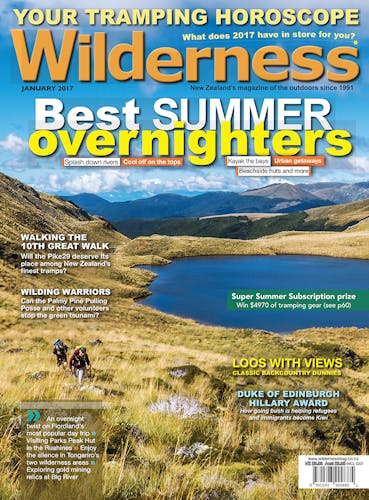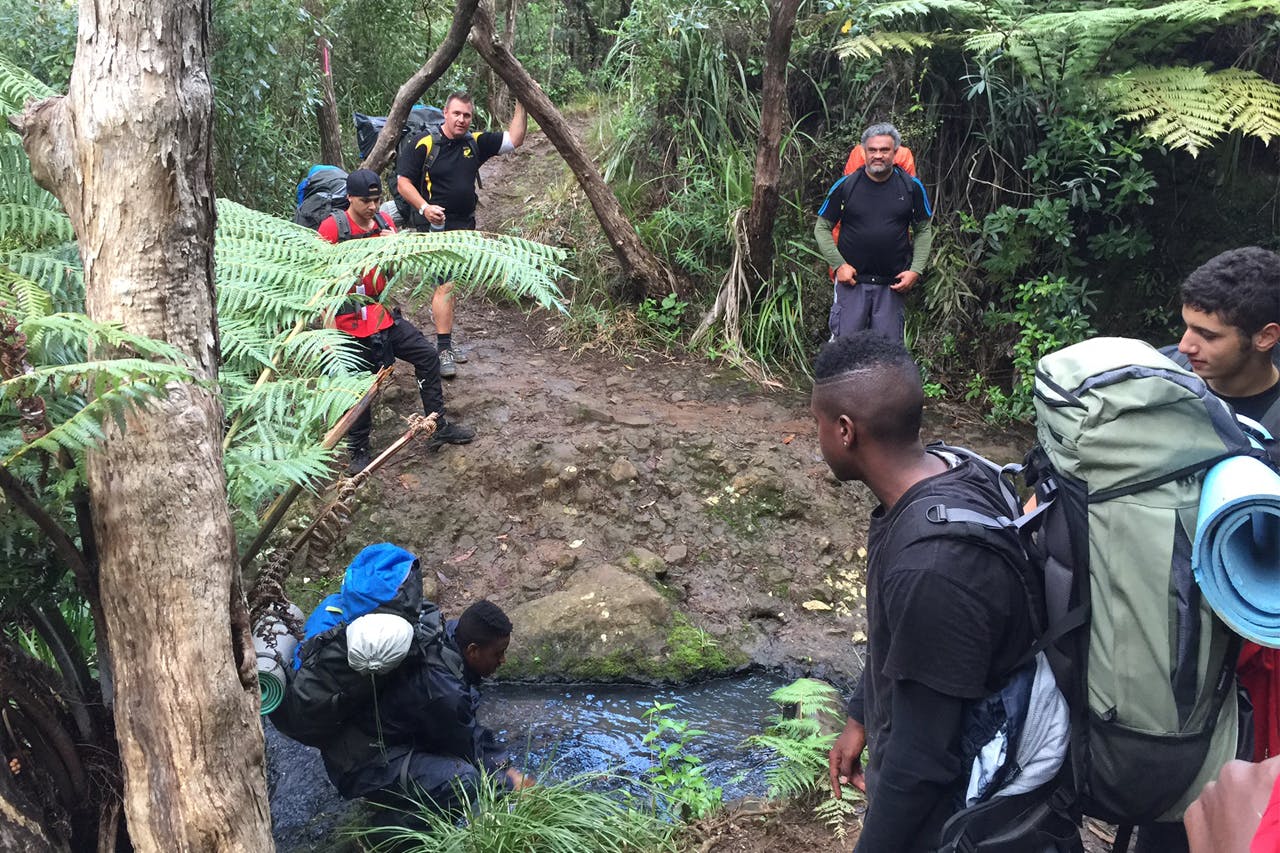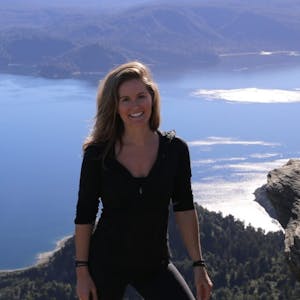In multicultural Auckland, where refugee students rub shoulders with immigrants and other ethnic minorities, the Duke of Edinburgh Hillary Award helps people from diverse backgrounds assimilate into New Zealand society.
FOR 16-YEAR-OLD Cook Islander Tairi Kimi, the Duke of Edinburgh Hillary Award is all about the positive vibes.
“The vibe makes me want to keep doing it. It’s a good vibe, it’s a happy vibe, it’s a different vibe,” he says.
Kimi, a student at One Tree Hill College in Auckland, had almost finished his second year of the award when he talked to Wilderness, and was gearing up for a three-day, two-night trip to Coromandel Forest Park.
The Duke of Edinburgh is a three-year programme in which students take part in four areas of development: skills (learning a musical instrument, for example), community service, physical education, and outdoor expeditions.
Kimi is an artist and an athlete: for his skill development, he paints. For the physical education requirement, he plays rugby and volleyball. His volunteer hours have been spent planting trees and cleaning stadiums with a group from his school. But the best part, Kimi says, is the tramping.
For his first overnight tramp, he went to Rangitoto and Motutapu islands with about 20 of his classmates.
“There were a lot of different cultures – Polynesians, Indians, Chinese – which gave it a good vibe,” Kimi says. They tramped for two days, slept on the beach, and climbed to the top of Rangitoto.
“I learned how to read a map, a few survival skills, and what to take on a tramp,” he says. While he’d been camping with his family before, he’d never been tramping. It was an eye-opening experience for Kimi, who says, for him, “It’s discovering the world. And at the end, everyone was just happy. You just have this feeling of accomplishment.”
Kimi is one of thousands of students who participate in the award each year in New Zealand. The Duke of Edinburgh programme started in 1956 in England, where it served as a youth development programme for young men. It was designed by a team of educators, athletes and explorers; among its founders were Kurt Hahn (founder of Outward Bound) and John Hunt (team leader for Sir Edmund Hillary’s Everest climb).
The programme admitted girls not long after its inception; however, in the beginning, the girls programme was centered around homemaking. Slowly the gender scales balanced, and the organisation spread around the world. It now operates in 140 countries and territories.
Duke of Edinburgh was introduced in New Zealand in 1963, and is now also referred to as the Hillary Award. There are more than 9000 students around the country who sign up for the bronze level each year.
Andy Woodhouse has worked with Duke of Edinburgh for 21 years. Hailing from England, Woodhouse first became involved in the programme while working as an educator at a school in the UK. He saw the benefits of it as a youth development plan, and started running the Duke of Edinburgh in three different youth centres.
“It was about inclusion,” Woodhouse says. “It was about getting young people from lower socioeconomic communities who were not traditionally involved with the award, and getting them on board.”
The programme is designed for youth over the age of 14, and it consists of four elements: community service, non-physical skills development, adventurous journeys, and physical recreation. There are three stages to the award; bronze, silver and gold. Bronze and silver take six months each, while gold is a year-long endeavour. In each stage, students complete a minimum of one hour per week in the service, skills, and physical recreation categories, and must also complete the training, practise and qualifying journeys for each level. Their progress in each area is marked by an assessor, whilst mentors, or award leaders, help students work through each stage and plan their journeys.
Students have the option of doing an exploration or an expedition for their adventurous journeys. An exploration, which takes more time, might be a close study of kauri dieback while staying at a basecamp set somewhere in the bush. An expedition – the more common type of journey – might be a two- to four-day walk on the Hillary Trail, or a horse trek on the beach. Students are encouraged to get creative; some opt for multisport adventures, combining tramping with cycling or even kayaking.
After facilitating Duke of Edinburgh in the UK, Woodhouse came to New Zealand to manage the national programme here.
In his decades of experience helping students complete the award, he says it’s constantly evolving as kids are more connected to the rest of the world, and busier in their day-to-day lives. While kids today are heavily distracted by screens, he says there’s a silver lining, because it means they’re typically more clued in.
“These days, young people are far more self-aware, more self-reliant, and in some cases, they’re starting from the place we were trying to get them to, years ago. They’re better connected, better educated,” Woodhouse says. However, the goals of the programme haven’t changed.
“The core outcomes are self-reliance, a good sense of identity, self-esteem, and ability to understand that effort equals reward.”
While it’s not too expensive to join the programme; just $37.50 for the coursework and materials each year, it’s still cost-prohibitive for some. Tramping gear can be costly, and the trips expensive. Plus, the time commitment excludes those students who have stressful lives at home.
The programme is constantly expanding to new communities; Woodhouse says they’re working with multicultural groups all over Auckland, from Pacific Island communities to refugee groups.
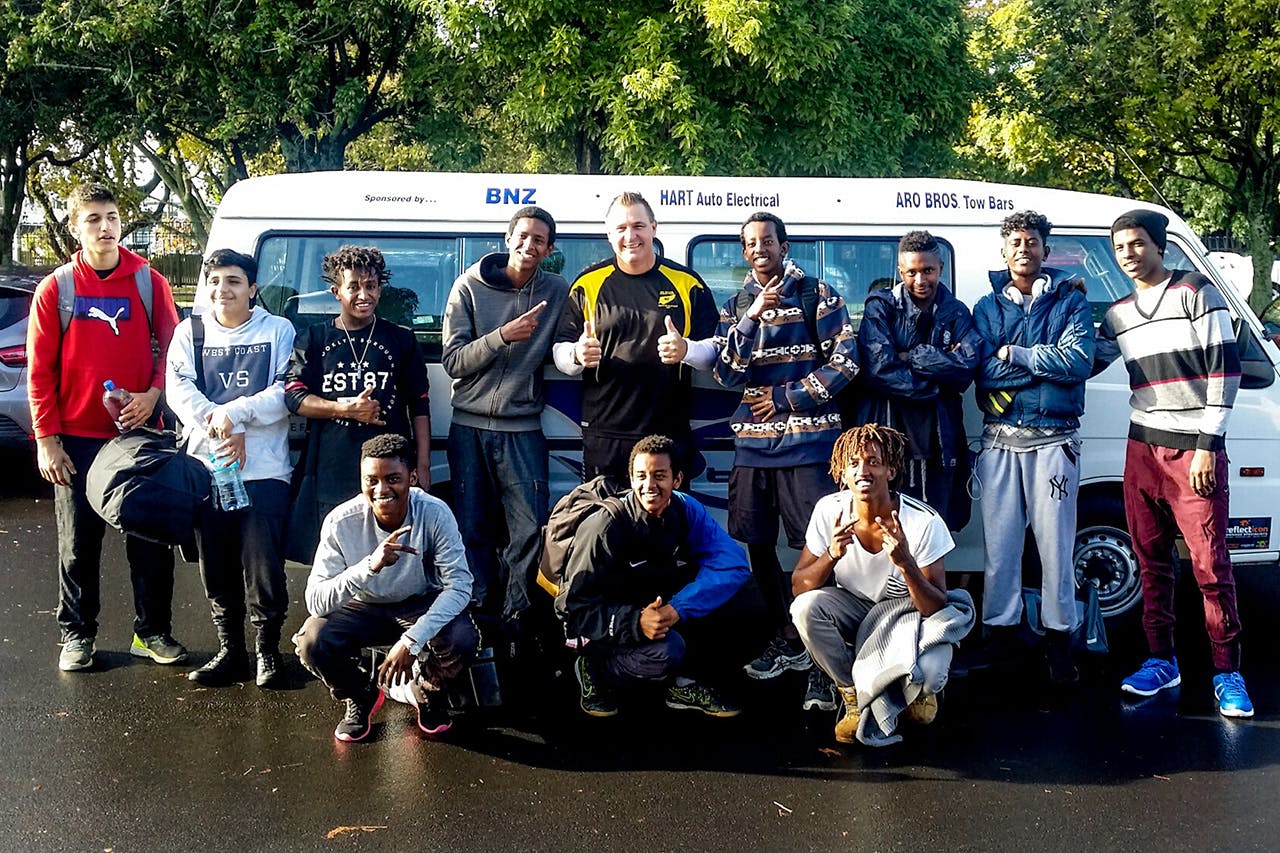
Being introduced to tramping through the Duke of Edinburgh award has helped these refugee students feel more ‘Kiwi’. Photo: Peniel Fa’amausili
Woodhouse focuses his energy on finding ways to give kids an experience that allows them to connect to nature, rather than become intimidated by it.
“Taking somebody from India, for example, who’s just come to New Zealand, and dressing them up in Gore-Tex and marching them out into the bush probably is a bit much. Rather, it’s about getting them out into the bush to explore, to connect with it, to understand that it’s not dangerous, and to see how that resonates with them.”
The Duke of Edinburgh began working with refugees a few years ago. “When it started, the adults were not that keen on letting kids go bush, because nobody told them there weren’t dangerous animals, or guys in utes with machine guns on top charging around,” Woodhouse says. “So, we had to do some work with the community to talk about how safe it is.”
The Auckland-based refugee students typically head into the Waitakere Ranges for their adventurous journeys. “They’re blown away that this is half an hour away from their house,” Woodhouse says, adding that the Somali students say it’s a lot like Somalia – it has beaches and bush – but without the dangers they’re used to in Africa.
“We take them out, and they say, ‘wow, I’ve been here four years, and I didn’t know this was here’ – because they’ve never left Mt Roskill.”
Woodhouse says migrant communities are almost entirely urbanised, and he doesn’t think it’s helpful for their assimilation into New Zealand society. “One of the important things, when you have refugee or migrant communities coming in, is to connect them to the stuff that Kiwis like about being Kiwis,” he says. “And that is jumping off the wharf, walking on the beach, going bush – because those are the things that recharge you.”
For many Kiwis, the wilderness is an open door for exploration. Many youngsters who grow up here learn a sense of belonging from endless hours spent in the bush and on the beach, and outdoor recreation is encouraged in most schools across the country.
But for those who are new to New Zealand, connecting to the land isn’t as easy.
In refugee communities, this is particularly prevalent. But there’s a national charity that’s working to alleviate that.
Mt Roskill Grammar School has one of the highest populations of refugee students; there are 67 students from many different countries such as Sudan, Syria, Ethiopia, and Somalia. In an effort to connect and assimilate the students with Kiwi culture, youth development organisation Blue Light has enlisted a group to partake in Duke of Edinburgh.
Blue Light is primarily made up of police officers who work with young people in communities, aiming to connect with low-decile schools and youth in areas where there’s a prevalence of drug use and crime.
One of the ways in which they do that is through Duke of Edinburgh; they have funding to enroll 40 students a year across New Zealand.
“Duke of Edinburgh connects easily with motivated, affluent kids,” Blue Light’s national manager, Brendon Crompton, says. “[The Hillary Award] struggles to get into Maori, Pacific, rural, and low-decile schools because the kids tend not to have the resources to do the award. So, we go out, find kids, sell it to them, and enroll them.”
Blue Light recruited 12 boys at Mt Roskill who agreed to be part of the programme. The group, made up of refugees from Somalia, Sudan, Syria, and Ethiopia, completed their bronze level this year under Crompton’s guidance.
The students all came to New Zealand within the last five years, Crompton says.
“The adults were not that keen on letting kids go bush, because nobody told them there weren’t dangerous animals, or guys in utes with machine guns on top charging around. We had to talk about how safe it is.”
“All of them are keen to become Kiwis, and part of this programme is to give them an experience that a lot of Kiwi kids have, which is tramping and camping in the New Zealand bush.
“It’s about assimilation. It’s about them feeling like they’re Kiwis,” Crompton says, who led the boys on their qualifying journey tramp into the Waitakeres.
None of the boys on the trip had ever been on a tramp before. Aside from the shelters set up by the UN at refugee settlement camps, none had ever slept in a tent.
They spent two days and one night on the Hillary Trail near Piha, where they camped out and tramped 18km. Crompton says they loved it.
Mt Roskill refugee coordinator Peniel Fa’amausili, says he’s seen a big difference in the boys; they’ve become far more confident.
“The boys have been great,” Fa’amausili says. “It takes them awhile to warm to people, but they did that quickly with the Blue Light crew, especially after the overnight tramp.” They began their Duke of Edinburgh experience with the tramp, which Fa’amausili says was perfect for getting them into the spirit of the award.
“Their confidence has really improved. That’s the biggest thing that I’ve seen. You see them walking around, saying hi, their heads held high. They’ve got a sense of belonging with the Duke of Edinburgh.”
In addition to the adventurous journey, Blue Light also coordinates the community service requirement of the award. Crompton says the boys met for a few Saturdays, painting over graffiti and cleaning churches. But, as to be expected, their favourite part of the award is the tramping, Fa’amausili says.
“They’re always asking, ‘When’s the next one, sir? When’s our next day out?’,’’ Fa’amausili says. “It’s given them something to look forward to.”
Not every school in New Zealand can provide guidance for Duke of Edinburgh students, which is why organisations such as Auckland Challenge exist.
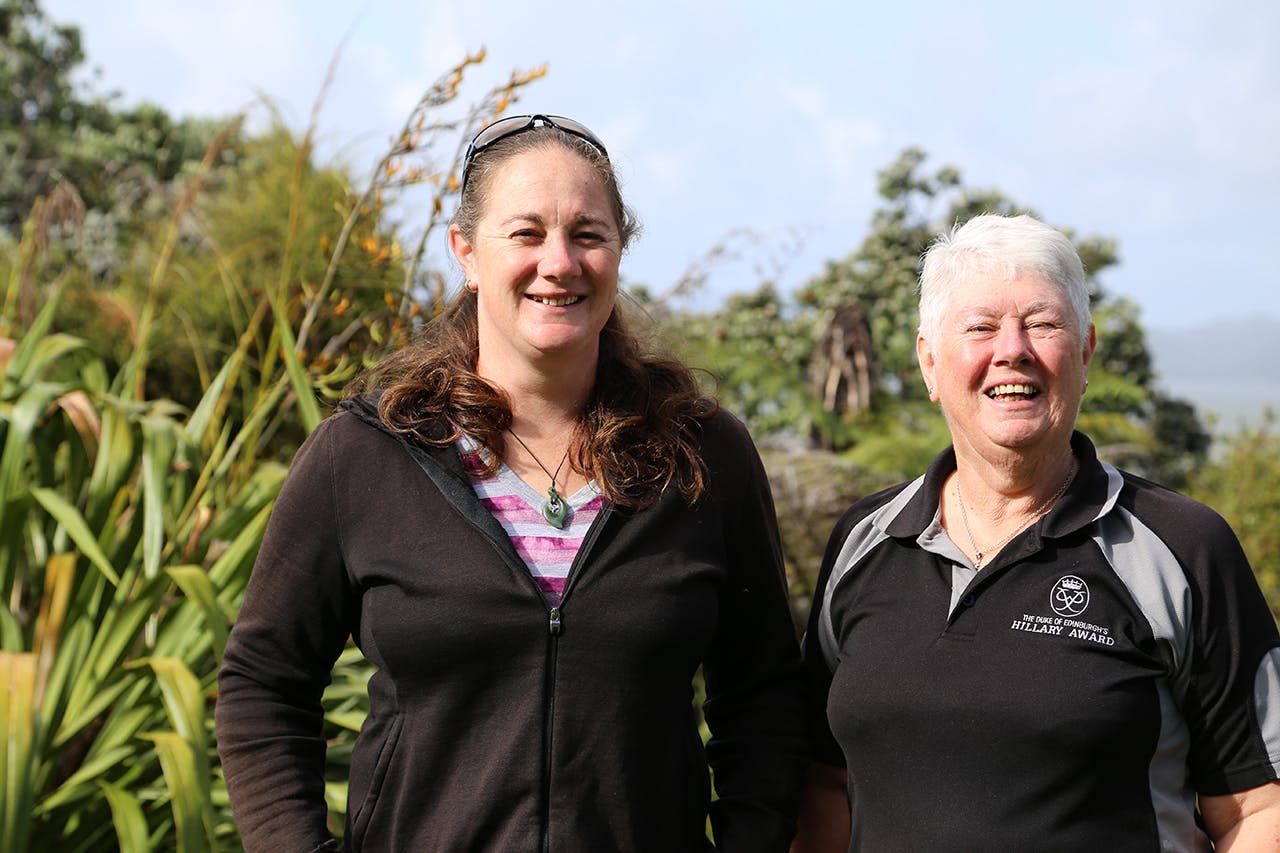
Kathryn Wood and Gemma Thompson have been helping students complete their DOE awards for 30 years. Photo: Meghan Walker
Kathryn Wood has been involved with the award for 30 years. In the 1980s, she was working at a school as a science technician, and had a British co-worker who encouraged Duke of Edinburgh for the students who were struggling at school. Wood was helping with the training, teaching first aid to the students, and introduced DOE to the Order of St John’s youth cadet programme.
“There were a lot of kids who didn’t have access to the award because the schools weren’t running it, or kids left the schools, or there were issues with the coordinators – something had stopped their progress,” Wood says. “I thought there had to be another way. I started off with three kids, and now we have about 1000.”
Auckland Challenge caters to individual students who want to do the award but aren’t able to through their schools. Staff work as mentors, instructors, and expedition leaders.
Wood’s daughter Gemma Thompson, now in her 30s, completed her gold level in 2002, and is an instructor for the organisation.
While the core requirements of the award haven’t changed much, Thompson has seen it evolve into a more structured programme with more supervision and checks and balances, particularly from a health and safety perspective.
“We try to help the kids focus on what they want to do when they leave school, so they can have almost a taster of what it might be like.” And for Thompson, that’s exactly what happened – she became a gymnastics coach after many years of coaching as part of her award requirements.
“If someone wants to be a vet, we get them to do service with the SPCA. If someone wants to be a doctor, we get them involved with St John to find out if they can actually deal with blood,” Thompson says.
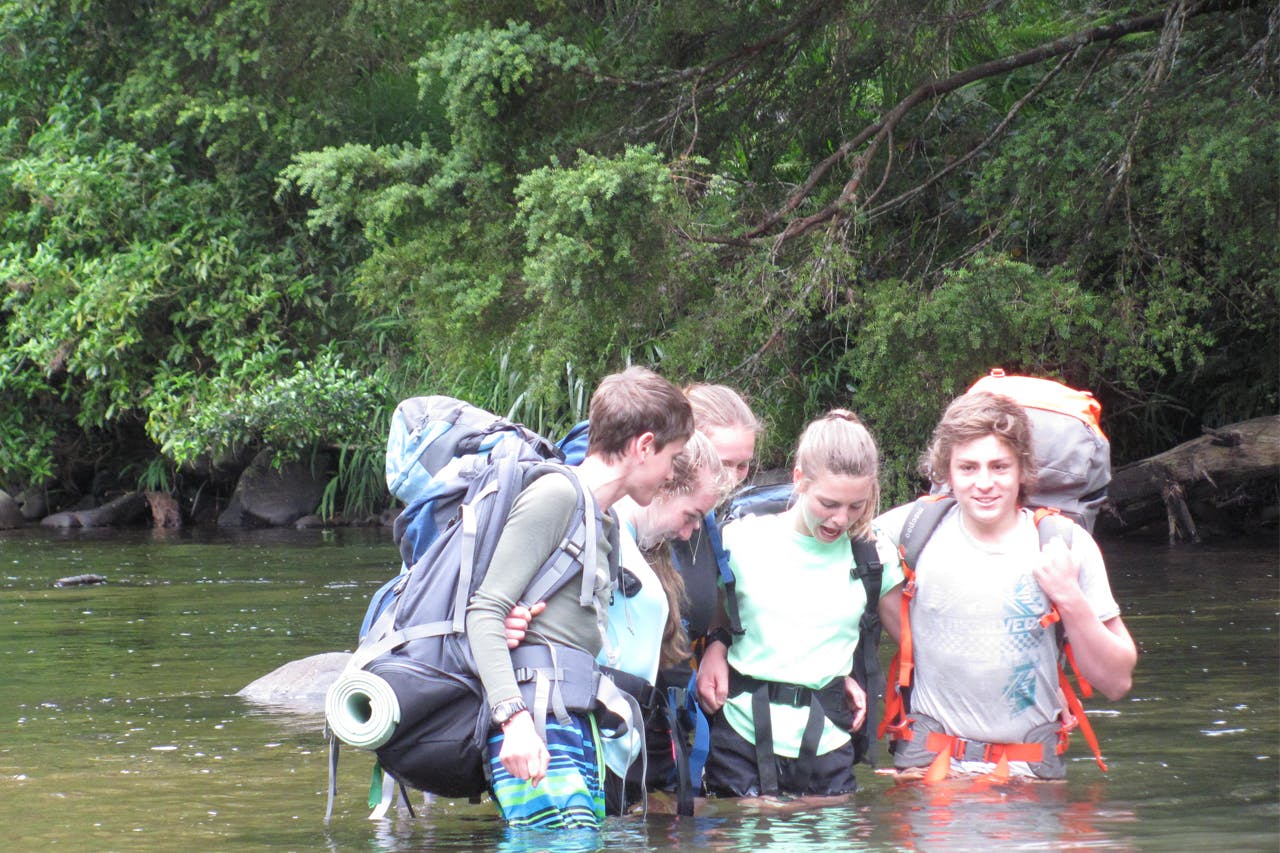
Those who participate in DOE say the tramping is the best part
Wood says they meet with individual students to really understand what it is they’re passionate about, and then do what they can to help them find opportunities that both satisfy their interests and fulfill their commitment to the award requirements.
“It’s all about the individual,” Wood says.
Many students, for their service requirement, will work at Salvation Army stores or hospice shops. There’s also a group of home-school kids who formed the Duke of Edinburgh Service Team, spending their service hours cleaning up gardens for families with single parents and raising money for families who need clothing for their children.
Most of the students they work with do their expeditions in the Waitakere Ranges, taking advantage of the plethora of options just west of Auckland.
In the past few years, the demographics of their students has changed a great deal. Wood says one-third of their students are foreigners, mostly coming from Asia. It’s presented some new dynamics, mostly in the sense that some of their students, having come from urban backgrounds, have barely spent any time outdoors or away from their families. The first night they spend in a tent can be a big learning curve.
“We have so many different cultures now,” Wood says. “We have some kids who grew up playing in the bush, but then we talk to kids from Korea and China, and they say, ‘well, this isn’t what we’ve ever done’. Any activity has been in a hall or indoors. So, we’re trying to build up their appreciation of what’s out there so they’ll also look after the bush, and make it their own, because they just don’t have that understanding of it.”
Thompson says the most important role she fulfills as a facilitator is as an expedition leader. “It’s about talking with the kids, as opposed to talking to the kids, and being ears for them.”
“And, inspiring them,” Wood adds.





